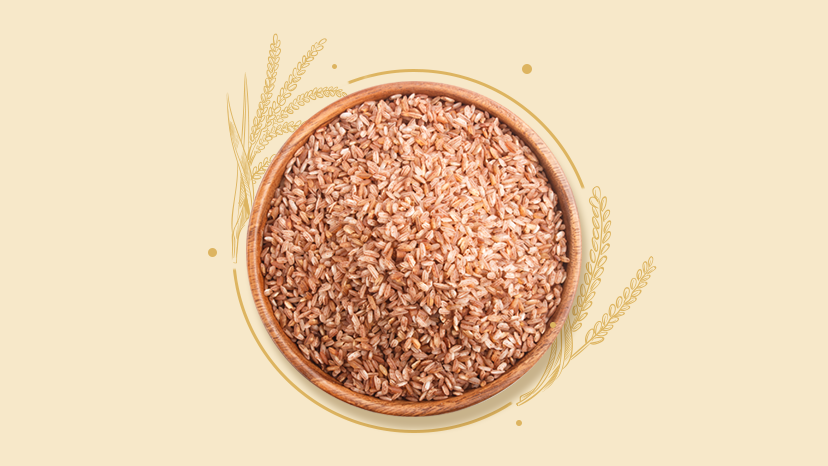Table of Contents
Rice is a staple food in many cultures and has been eaten for centuries. It’s no wonder that there are so many different types of rice available on the market today. One type of rice that has become increasingly popular in recent years is brown rice. Unlike white rice, which is stripped of nutrients, brown rice is a whole grain containing fibre, vitamins, and minerals. But is brown rice really good for you? This article explores the benefits of brown rice to see if it can help with weight loss and improve your overall health.
What is brown rice?
Brown rice is a whole grain that has been minimally processed. It still contains the bran and germ, which are removed from white rice. Brown rice is a good source of fibre and nutrients, including magnesium, phosphorus, selenium, thiamine, niacin, and vitamin B6. It also has a lower glycemic index than white rice, meaning it won’t cause spikes in blood sugar levels. Brown rice may help with weight loss by keeping you full for longer and helping regulate blood sugar levels.
Benefits of brown rice
Brown rice has more benefits than white rice. Brown rice is a whole grain, which means it contains all the parts of the grain—the bran, germ, and endosperm. White rice has had the bran and germ removed, leaving only the endosperm.
The bran and germ are where most of the nutrients are found in a grain of rice. This includes vitamins, minerals, fibre, and antioxidants. Brown rice is a good source of fibre, with one cup providing 3.5 grams. Fibre is important for digestive health and can help reduce cholesterol and blood sugar levels.
|
Property |
Brown Rice |
White Rice |
|---|---|---|
|
Health benefits |
Higher in nutrients and fibre due to the presence of the bran and germ layers. It may help with weight management and lower the risk of heart disease and diabetes. |
Lower in nutrients and fibre due to the removal of the bran and germ layers. |
|
Cook time |
Longer, typically 45-50 minutes. |
Shorter, typically 15-20 minutes. |
|
Price |
Generally more expensive due to higher demand and lower production. |
Generally less expensive due to lower demand and higher production. |
|
Nutrients |
Higher in vitamins and minerals such as thiamin, niacin, vitamin B6, magnesium, phosphorus, and selenium. |
Lower in vitamins and minerals due to the removal of the bran and germ layers. |
|
Flavour |
Nutty and slightly chewy. |
Mild and softer. |
|
Texture |
Chewier and firmer. |
Softer and fluffier. |
|
Storage |
It can be stored for longer periods of time due to the presence of the bran layer, which acts as a natural protector. |
More perishable due to the absence of the bran layer. |
Brown rice is also a good source of magnesium, with one cup providing 21% of the recommended daily intake. Magnesium is involved in over 300 biochemical reactions in the body and is essential for good health. It helps to maintain normal muscle and nerve function, supports a healthy immune system, and keeps bones strong.
Another benefit of brown rice is that it has a lower glycemic index than white rice. This means it doesn’t cause spikes in blood sugar levels. It is beneficial for people with diabetes. Brown rice is also a good source of manganese, selenium, phosphorus, and copper. Replace white rice with brown rice for a healthier body.
Weight loss and brown rice
Brown rice is a whole grain and a good source of fibre. It’s also low in calories and has been shown to aid in weight loss.
When it comes to weight loss, brown rice may be more beneficial than other types of rice. The Journal of Nutrition’s studies show that participants who ate brown rice lost more weight and had a lower body mass index(BMI) than those who ate white rice.
Another study from the American Journal of Clinical Nutrition found that women who ate brown rice were less likely to be overweight or obese than those who ate white rice.
The fibre content of brown rice can also help with weight loss. Fibre helps keep you feel full after eating, so you’re less likely to overeat. It also slows down the absorption of sugar into your bloodstream, which can help prevent spikes in blood sugar levels and hunger cravings.
If you’re looking to lose weight, brown rice is a good option to include in your diet. Try replacing white rice with brown rice in your favourite recipes, or enjoy a bowl of brown rice with vegetables and lean protein for a filling and satisfying meal.

Nutrition and brown rice
Brown rice is a whole grain that is packed with nutrients. It is a good source of fibre and protein and contains vitamins and minerals essential for good health. Brown rice can help you lose weight, lower cholesterol, and improve overall health.
When it comes to nutrition, brown rice is a powerhouse. It is a good source of fibre, protein, vitamins, and minerals. Brown rice can help you lose weight, lower cholesterol, and improve overall health.
How to cook brown rice?
Brown rice can be cooked in several ways, including boiling, baking, and frying.
When cooking brown rice, it is important to use the proper ratio of water to rice. The general rule is to use two cups of water for every cup of rice. If you use a different method, such as the absorption method, check the package directions for the correct ratio.
Bring the water to a boil in a large pot before adding the rice. Stir the rice into the water, then reduce the heat to medium-low and cover the pot. Simmer until all the water has been absorbed and the rice is tender and fluffy. This should take about 45 minutes.
If you are baking brown rice, preheat the oven to 350 degrees Fahrenheit before adding the rice to a baking dish. Cover the dish and bake for 30-40 minutes or until the rice is tender and cooked.
Fried brown rice is a popular way to cook this grain in many Asian countries. To make fried brown rice, stir-fry onions and garlic in a tablespoon or two of oil over medium-high heat until they are softened. Add the rice and continue stirring for several minutes until it is evenly coated with oil and turning golden brown. Add your desired seasonings (soy sauce or curry powder) and vegetables, then continue cooking until everything is cooked properly.
Conclusion
Brown rice has many benefits of brown rice and can help with weight loss and improve your overall health. If you are looking for a delicious, healthy, affordable food option, look no further than brown rice!
FAQs
Is it okay to consume brown rice every day?
It is generally considered safe to consume brown rice in moderation as part of a balanced diet. Eating too much of any food item can lead to potential health problems, so paying attention to portion sizes and keeping a healthy and varied diet is important.
Is brown rice good for weight loss?
Brown rice can be a beneficial part of a weight loss program. It is a low-calorie, high-fibre food that can help you feel full for longer and stick to a healthy eating plan. In addition, the vitamins and minerals in brown rice can help support healthy weight management.
What are the disadvantages of brown rice?
Brown rice contains phytic acid, which may reduce the absorption of certain minerals and enzymes. Additionally, brown rice can contain arsenic, a known toxin. Although if properly prepared and cooked, the levels of arsenic are usually not dangerous for consumption.
What rice is the healthiest?
Brown rice is generally considered to be one of the healthiest forms of rice. It is an excellent source of fibre, vitamins, and minerals and is also low in calories and fat, making it a great addition to a balanced diet.
Who should avoid eating brown rice?
People with a sensitivity to arsenic should avoid eating brown rice. Additionally, those who have Celiac disease or are allergic to gluten should avoid this grain.















